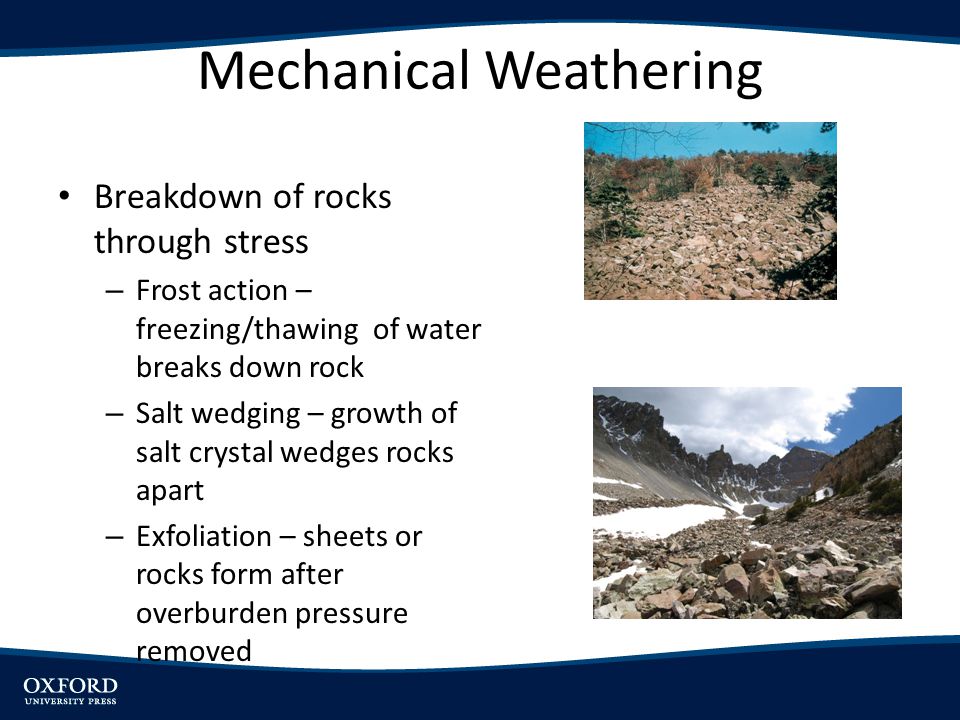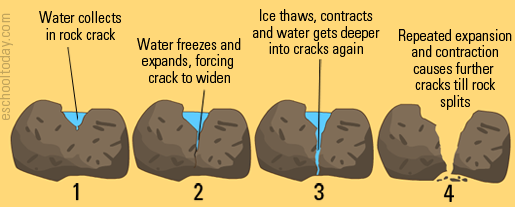Which of These Is Not a Process of Mechanical Weathering
However chemical and physical weathering often go hand in hand. Mechanicalphysical weathering - physical disintegration of a rock into smaller fragments each with the same properties as the original.

Lesson 1 Weathering Weathering Acts Mechanically And Chemically To Break Down Rocks Through The Action Of Earth Processes Such As Freezing And Thawing Ppt Video Online Download
Occurs mainly by temperature and pressure changes.

. Each fragment is termed as a sediment. These sediments break down further resulting in the formation of soil. Many standards call up this practice.
Weathering is a term which describes the general process by which rocks are broken down at the Earths surface into such things as sediments clays soils and substances that are dissolved in water. Water seeps into cracks in rocks. Physical weathering can occur due to temperature pressure frost.
Physical mechanical weathering Mechanical weathering is the application of force to physically fragment rock into smaller pieces called clasts. Process of rocks crumbling due to rain wind or other atmospheric conditions. Chemical weathering - process by which the internal structure of a mineral is altered by the addition or removal of elements.
The primary process in physical weathering is abrasion the process by which clasts and other particles are reduced in size. The 3 main processes of chemical weathering are. One of the simplest forms of mechanical spalling is plate impact in which two waves of compression are reflected on the free-surfaces.
Change in phase mineral type. Shall we have a detailed look at them. Some examples of it are.
If erosion does not occur unconsolidated sediment will remain in place mix with. It is the most important process for soil formation. The firm can conduct various types of tests on different parts of the product allowing evaluators to pinpoint the source of the issues and potentially identify ways to solve them.
Decomposition of rocks and minerals by various chemical processes is called chemical weathering. Sediments were described in the Rocks chapter. Each sediment is a piece of rock combined with minerals andor the remains of animals and plants.
These forces lead to mechanical weathering which is defined as the physical breakdown of rock by environmental factors. Once these sediments are separated from the rocks erosion is the process that moves the sediments. The process of weathering typically begins when the earths crust is uplifted by tectonic forces.
Water plays a key role in each of these chemical reactions. It breaks into pieces. Act in which earth is worn away often by water.
ASTM G154 is a standard that is used as the basis for all other accelerated weathering standards that use fluorescent UV light sources to simulate exposure to natural sunlight. The weathering process disaggregates rock but it does not remove rock material from its original location. CHAPTER 6 Weathering and Soil 1.
Login will be required December 31 2021 to access all the CPALMS original student tutorials. Also called mechanical weathering and physical weathering. To have a deeper understanding of these processes lets explore the different types of mechanical weathering.
It breaks down rocks by the exertion of a physical force and does not involve any chemical change. In this lesson we will take a look at how this process works and see. There are five major types of mechanical weathering.
Erosion is the next chapters topic. Mechanical spalling occurs at high stress contact points for example in a ball bearingSpalling occurs in preference to brinelling where the maximal shear stress occurs not at the surface but just below shearing the spall off. Types of Mechanical Weathering.
Chemical weathering is the process of transforming a rocks composition through chemical reactions. Erosion is the physical removal of rock and sediment from its original location by an agent such as water ice air gravity or animalhuman interference. Physical weathering also known as mechanical weathering is the class of processes that causes the disintegration of rocks without chemical change.
Thermal expansion frost weathering exfoliation abrasion and salt crystal growth. Physical weathering also called mechanical weathering is a process that causes the disintegration of rocks mineral and soils without chemical change. The process of weathering breaks down a rock into smaller-sized fragments.
If a product is not performing as expected at any stage of the product development process the company may perform tests to help determine the cause of the problem. This process is said to mark the start of many geomorphological processes. For a list of these by product category please see the QUV standards list.
With weathering rock is disintegrated. For example buildings statues and monuments are subject. We see chemical weathering everywhere.
Series of pipes gutters or other waterways used to carry off excess water. The four forces of erosion are water wind glaciers and. Weathering is the process that changes solid rock into sediments.
The primary process in physical weathering is abrasion the process by which clasts and other particles are reduced in size. ASTM G154 Uses and Factors to Be Considered. To break up or disintegrate.
Chemical weathering takes place mainly at the surface of rocks and minerals with disappearance of certain minerals and the formation of secondary products new materials.

Weathering What Is Weathering The Physical Chemical And Biological Processes That Break Down Rocks And Minerals Turning Large Particles Into Smaller Ppt Download

Fluvial Processes Weathering And Mass Movement Geography Myp Gcse Dp
No comments for "Which of These Is Not a Process of Mechanical Weathering"
Post a Comment